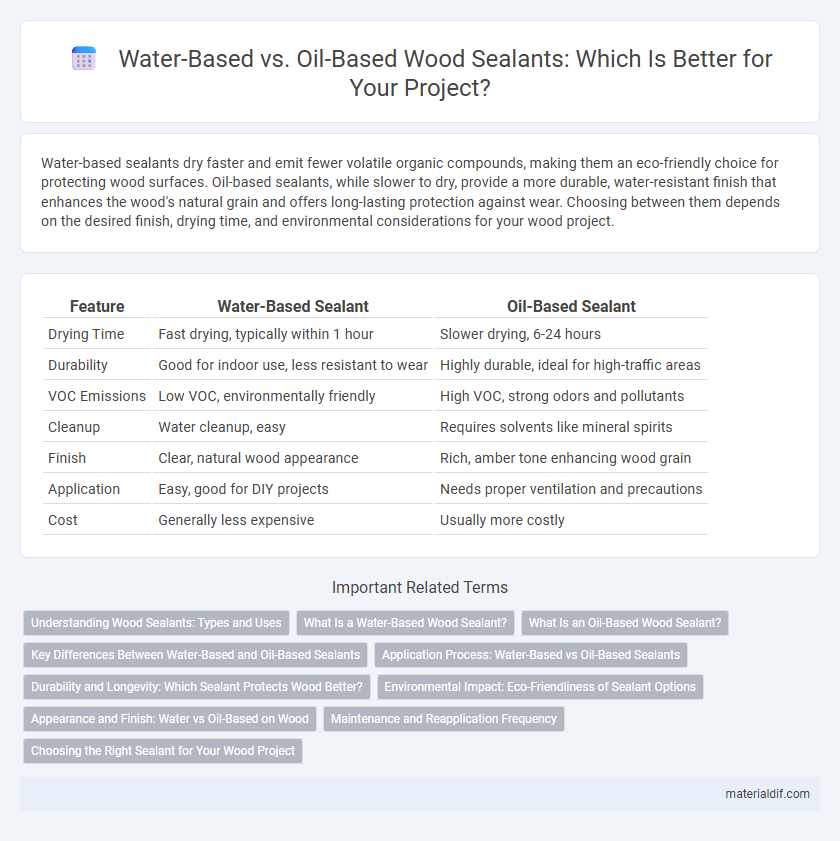Water-based sealants dry faster and emit fewer volatile organic compounds, making them an eco-friendly choice for protecting wood surfaces. Oil-based sealants, while slower to dry, provide a more durable, water-resistant finish that enhances the wood's natural grain and offers long-lasting protection against wear. Choosing between them depends on the desired finish, drying time, and environmental considerations for your wood project.
Table of Comparison
| Feature | Water-Based Sealant | Oil-Based Sealant |
|---|---|---|
| Drying Time | Fast drying, typically within 1 hour | Slower drying, 6-24 hours |
| Durability | Good for indoor use, less resistant to wear | Highly durable, ideal for high-traffic areas |
| VOC Emissions | Low VOC, environmentally friendly | High VOC, strong odors and pollutants |
| Cleanup | Water cleanup, easy | Requires solvents like mineral spirits |
| Finish | Clear, natural wood appearance | Rich, amber tone enhancing wood grain |
| Application | Easy, good for DIY projects | Needs proper ventilation and precautions |
| Cost | Generally less expensive | Usually more costly |
Understanding Wood Sealants: Types and Uses
Water-based sealants offer quick drying times, low odor, and easy cleanup, making them ideal for interior wood projects that require a non-toxic finish. Oil-based sealants penetrate deeper into wood fibers, enhancing durability and providing richer color tones, which is beneficial for high-traffic areas or exterior wood surfaces. Choosing between water- and oil-based sealants depends on factors like project location, desired finish, drying time, and environmental considerations.
What Is a Water-Based Wood Sealant?
A water-based wood sealant is a protective coating composed primarily of water and acrylic or latex polymers, designed to penetrate wood surfaces and create a durable, clear finish that preserves the natural appearance. It offers faster drying times, low odor, and minimal VOC emissions compared to oil-based sealants, making it environmentally friendly and suitable for indoor use. These sealants provide effective resistance against moisture, UV rays, and mildew, enhancing the wood's longevity while maintaining breathability.
What Is an Oil-Based Wood Sealant?
An oil-based wood sealant is a protective coating formulated from natural or synthetic oils that penetrate deeply into wood fibers, enhancing durability and water resistance. It forms a strong, flexible barrier that guards against moisture, stains, and wear, making it ideal for outdoor and high-traffic wooden surfaces. These sealants usually cure slower than water-based options, offering richer color enhancement and longer-lasting protection.
Key Differences Between Water-Based and Oil-Based Sealants
Water-based sealants dry faster, emit fewer volatile organic compounds (VOCs), and offer easier cleanup with soap and water, making them environmentally friendly and user-safe. Oil-based sealants provide superior durability, deeper penetration into wood fibers, and a richer finish, but require mineral spirits for cleanup and release stronger odors. Choosing between the two depends on project needs, balancing drying time, environmental impact, and desired finish quality.
Application Process: Water-Based vs Oil-Based Sealants
Water-based sealants dry faster, typically within 1 to 2 hours, allowing for quicker recoating and reduced downtime during wood finishing projects. Oil-based sealants require longer curing times, often 6 to 8 hours or more, and need thorough surface preparation to ensure proper adhesion. Applying water-based sealants is generally easier with soap and water cleanup, while oil-based sealants demand mineral spirits or paint thinner for cleaning brushes and spills.
Durability and Longevity: Which Sealant Protects Wood Better?
Water-based sealants offer faster drying times and lower VOC emissions while providing good flexibility, making them ideal for indoor wood surfaces that require moderate protection. Oil-based sealants penetrate deeper into the wood fibers, forming a tougher, more durable barrier that enhances water resistance and extends the lifespan of outdoor or high-traffic wood surfaces. For maximum longevity and superior protection against moisture, oil-based sealants generally outperform water-based options in preserving wood quality over time.
Environmental Impact: Eco-Friendliness of Sealant Options
Water-based sealants emit significantly lower levels of volatile organic compounds (VOCs), reducing air pollution and health risks compared to oil-based alternatives. The biodegradability of water-based products enhances soil and water safety, making them preferable for sustainable wood treatment. Oil-based sealants, while durable, contribute to higher VOC emissions and contain petroleum-derived chemicals, presenting greater environmental hazards throughout their lifecycle.
Appearance and Finish: Water vs Oil-Based on Wood
Water-based sealants provide a clear, non-yellowing finish that preserves the natural color and grain of wood, making them ideal for light or delicate woods. Oil-based sealants impart a warm, amber tone that deepens the wood's color and enhances grain contrast, offering a richer, more traditional appearance. The finish of water-based sealants dries faster and remains more flexible, while oil-based finishes create a harder, more durable coating with a glossy sheen.
Maintenance and Reapplication Frequency
Water-based sealants require more frequent reapplication, typically every 1-2 years, due to their faster wear and susceptibility to UV damage. Oil-based sealants offer longer-lasting protection, often needing reapplication every 3-5 years, as they penetrate deeper and resist moisture more effectively. Maintenance for water-based sealants involves regular cleaning to prevent buildup, while oil-based options demand less frequent upkeep but may require solvent-based cleaners.
Choosing the Right Sealant for Your Wood Project
Water-based sealants offer faster drying times, lower odor, and easy cleanup, making them ideal for indoor wood projects and eco-conscious users. Oil-based sealants provide superior durability, deeper penetration, and richer finish, perfect for exterior wood exposed to harsh weather conditions. Selecting the right sealant depends on the wood type, project location, desired finish, and environmental considerations.
Water-Based Sealant vs Oil-Based Sealant Infographic

 materialdif.com
materialdif.com